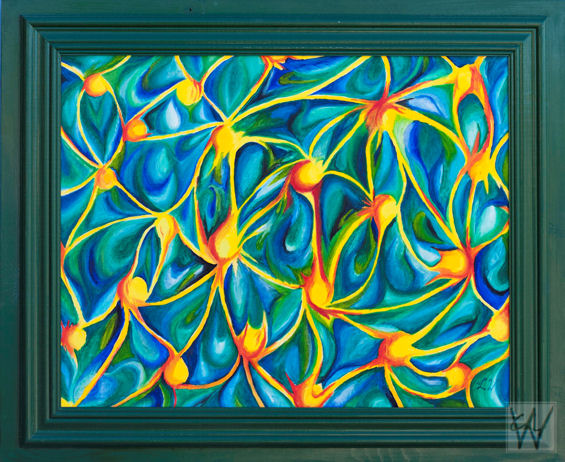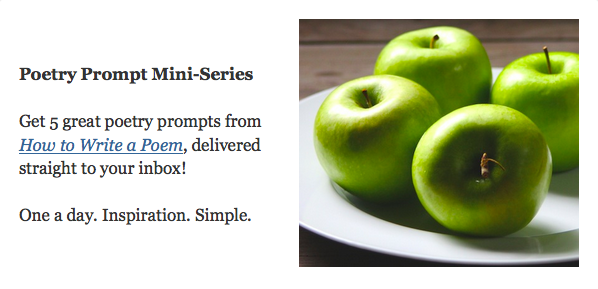
Registered nurse Lisa Wayman is board-certified in advanced holistic nursing, which, in simplest terms, is a relationship-based way to care for the ill that is grounded in the philosophy that a patient becomes well when the whole person — body, mind, spirit — is treated and healed. In practice, a holistic nurse “partners” with a patient to facilitate healing and wellness.
Wayman also is an artist with a special interest in art’s role in improving patient outcomes. Currently, she is pursuing studies in how art can promote whole-person healing and resilience. She herself has had first-hand experience: She turned to painting when her young son Joseph became ill in 1996 with the cancer that eventually claimed his life two years later. Her art-making, she believes, was a means to care for her soul during a period of intense grief.
In an interview by e-mail, Wayman spoke with me about her professional pursuits and interests and her own experience using art to respond to and transform suffering and loss.
__________________________
Lisa, how did you become interested in holistic nursing?
As a nursing student, I was really not into holistic nursing. I told myself that I got into nursing because I needed a steady job and to make money. I think I was embarrassed by the sentimentality of wanting to change people’s lives [and] socialized to a part of the profession that valued reasoning and action [over] feeling and connection with patients. I had the fortune of having H. Lea Gaydos, an American Holistic Nurse Association (AHNA) “Nurse of the Year”, as my instructor. She used to say that caring was the essence of nursing. I actually rolled my eyes [at that]. I thought I could be a nurse and help people simply by having good technical skills, and that nursing wouldn’t require relationship or a change in who I was.
What changed your mind?
A year of working in the ICU. I got pretty beaten up. ICU is rough, and I was working with my feelings walled off so that I wouldn’t be hurt [yet] I talked about it, dreamt about it, and worried about it; the suffering was more than I was prepared for. I just didn’t have the self-care skills or the maturity to enter into relationships with my patients and [still be able] to let go. I went to Gaydos and asked for help. She got me started in holistic nursing. I still worked in the ICU but started taking little steps. . . entering into real relationships. Paradoxically, [allowing myself to care more] let me let go of the patients when I went home.
[A] few years later [when] Joe got sick, I learned big lessons in how important the healing relationship is. . . The experience of caring for him while he was ill and dying catalyzed a transformative shift of my consciousness and greatly enlarged my practice. The things I knew in my head about who I was and how to be a nurse. . . moved into my heart and my whole being through caring for Joe.
After he died, I needed to know more, so I went back to school for a master’s in holistic nursing.
How does art therapy differ from art as healing intervention?
Art therapy is pretty well-defined; the therapist uses art to diagnose and treat psychiatric illness. In art as healing intervention, all kinds of people — nurses, artists, physicians, etc. — use art to promote whole-person healing and resilience.
I want to study how creating art works to help [promote] resilience, so that practitioners can hone their programs to better meet patient needs.
You’ve mentioned “resilience research”. What does that entail? How do you define “resilience” and how might the presence of art in our lives affect our ability to be resilient?
That is a really interesting question.
Resilience has been defined as recovery, growth, and transformation. Transformation or, as some call it, transcendence, is the most resilient response to a stressor. It’s a qualitative change in [your sense of] who you are in response to a stressor.
I’m working on an article to model the process of resilience. I’m looking at concepts of resilience, how the concepts are related, and how the creative process can influence response to stressors to promote transcendence.
When your son was diagnosed with cancer, you found yourself strongly called to paint. What do you think prompted your turn at this particular point to active art-making, and to painting (as opposed to some other art form) specifically?
I think I painted when Joe was ill because I had painted before. I had created Dancing with God about a year before Joe was diagnosed; so, when he got sick, the paint just called to me. I am a visual thinker and I experience a visceral pleasure when I put one color next to another and it is just right. I get such joy when [the colors] touch. So maybe that joy pulled me to paint. Maybe it was that words wouldn’t hold the experience. I can’t be certain why I turned to painting, but I’m glad that I did.
What did (or do) your paintings show you or teach you about yourself?
I think my paintings are a way for me to learn about what I really feel and think. It is easy to lie to myself in words but symbols in paint and non-verbal aspects of visual art express the truth. . . allow [my] subconscious to express itself. . . [T]he paint brings out what is hidden and lets me discover it on my own. For example, I painted New Beginnings when our daughter left home and did not contact us for four years. I knew I was angry and started a large canvas with red slashes; then I was moved to paint blue tear drops down the middle and realized that I was more sad than angry. The painting moves from left to right, from how things were, through [my] anger, to new beginnings. I painted a circle on the right [that] became a symbol of a new and different but whole life. I felt much more hopeful and had a goal — to work toward that new life — after I completed the painting.
Do you think we all have the capacity to experience the kind of transformative effects you’ve experienced through art-making? What, besides catastrophic illness or loss, might impel a person to turn to art? What might hold us back from turning to art?
I think that transformation is the norm [but, like child development, ] an uneven and jumping type of development. We think one way, then tension starts to build and we jump to a different level. Some people do this as a gift of grace, some people work hard to prepare for the opportunities, so when a breaking point comes, [they can handle] it. Me? I must be a slow learner, because I seem to take the hard way and need a big catalyst to push me out from where I am into something new.
Anything that someone is working on can [prompt a] turn to art.
The biggest barrier to trying art is being afraid that we won’t be good at it.
Lisa Wayman is the author of “Walking with Persephone: A Journey Toward Healing” in Creativity & Madness: Psychological Studies of Art and Artists (Barry M. Panter, Ed.; Manipal, India: American Institute of Medical Education Press, 2009). She also contributed the chapter “The Art of Survival” to The Art of Grief: The Use of Expressive Arts in a Grief Support Group (Series in Death, Dying, and Bereavement) (J. Earl Rogers, Ed.; New York: Routledge, 2007). See more of Lisa Wayman’s work in her online gallery.
Please read Maureen’s complete two-part interview with Lisa Wayman on November 29 and November 29 at Writing Without Paper.
Images by Lisa Wayman. Used with permission. All rights reserved. Post by Maureen E. Doallas, author of Neruda’s Memoirs: Poems.
_____________________________
Click to get FREE 5-Prompt Mini-Series
- Persecuted Poets: Hearing the Voices Beyond Our Borders - November 30, 2016
- Writing with Matisse in Mind - October 26, 2016
- Healing with Poetry: Interview with Fred Foote (Part 3) - September 10, 2015



Donna says
I can’t even write what I’m feeling here because I can’t get to it all, but I want to say thank you so much for this post Maureen… and Lisa your strength, sharing and calling are so powerful. There are several people I need to share this with.
Maureen Doallas says
Donna,
Thank you for reading and commenting so generously. Lisa and I “talked” at some length. I will be publishing the complete interview in late November on my blog.
Lisa Wayman says
And Maureen, thank you so much for making my comments so easily readable. I appreciate your time and effort.
L. L. Barkat says
This is amazing. A side of Lisa I have never known (for I knew Lisa when we were friends in high school).
This especially touched…
“It is easy to lie to myself in words but symbols in paint and non-verbal aspects of visual art express the truth”
I think that is where the connection exists between art and poetry. Poetry is images. I experience what Lisa is saying, when I simply engage with images, though my medium is words.
Lisa Wayman says
Laura, I have so enjoyed your poetry which really is images. It is easier for me to speak in paint than in words, so I enjoy your words and express myself in color.
Maureen Doallas says
Lisa was frank in our interview, and I appreciate that very much.
I think it will be interesting to see where her studies lead her. The field is wide-open in research possibilities.
Shirley Erikson says
Lisa,
You may not remember me, but I’m a friend of your mom and dad, and you were very helpful
when I was in the throes of figuring out how to get a pacemaker! I think your mom may have mentioned the outcome., but in case you’ve forgotten, I got the pacemaker I needed, so I always think of you in connection with that. It changed my life!
I’m enjoying your colorful, wonderful rendering of the way we are connected in life and death, across time and space, sickness and health,and all the other “opposites” that fill out lives. I’m also reminded of the brain and how our neurons send and receive
information constantly, making sense out of the world we live in. Thanks very much.
Best wishes, Shirley Erikson
Lisa says
Hi Shirley,
Of course I remember you. I am glad you are doing so well. Stay well and happy.
Lisa